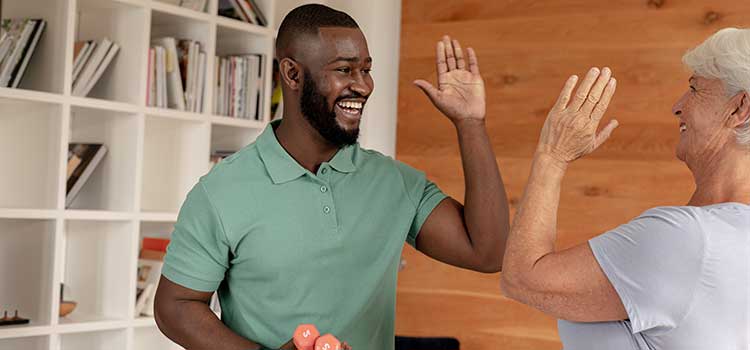Becoming a physical therapist: Steps, specialties and FAQs

Physical therapy may not be the first thing that comes to mind when you envision natural healing, but this career fits right in. Becoming a physical therapist empowers you to improve the quality of people’s lives through movement.
What is a physical therapist?
Physical therapists are dynamic healthcare professionals that aim to maximize the physical mobility of their patients so that they can lead healthy, active lives. When someone’s mobility is compromised as a result of illness, injury, disability, or another chronic condition, physical therapists can help. Physical therapists—with the help of physical therapist assistants or PTAs—use movement and hands-on techniques to achieve their goals, which include managing pain and using exercise to avoid surgery and prescription drugs.

“The common thread of physical therapy that is our claim to fame is that we’re movement experts,” said Janis McCullough, a physical therapist and assistant teaching professor with the University of Washington’s Division of Physical Therapy. “We analyze movement. We want to improve people’s lives, to get them moving, and figure out how they can access their environment, back to their goals in their life.”
Physical therapists are goal-oriented problem-solvers with an innate desire to help others. If this sounds like you, you may be a good fit to join to the estimated 15,400 new physical therapist professionals each year, according to the U.S. Bureau of Labor Statistics (BLS). In this holistic career, you’ll meet with a diverse array of people of all ages and abilities to determine their needs, set goals and execute a treatment plan.
Physical therapy specialties
Physical therapists have the opportunity to specialize in multiple areas of expertise. This can be a great option for people who know they want to work with certain groups or certain conditions so they can tailor their career to their unique interests. The American Board of Physical Therapy Specialties (ABPTS) currently offers 10 board-certified specializations that physical therapists can pursue:
How to become a physical therapist (in 6 steps)
Earn a bachelor’s degree in a related field.

Before you can graduate from a Doctor of Physical Therapy (DPT) program, you’ll need a bachelor’s degree first. No matter what you major in, you’ll want to take enough health and science classes to satisfy the prerequisites for DPT programs.
What should I major in?
Some common majors for prospective physical therapists include kinesiology, health sciences, biology, exercise science and more.
Another option is to enroll in a 3+3 curricular format offered by some schools, where you complete a bachelor’s degree in three years that directly prepares you for a three-year DPT program. This allows you to fast-track your education in slightly less time.
Graduate from a CAPTE-accredited DPT program.

All physical therapists must complete a Doctor of Physical Therapy (DPT) program accredited by the Commission on Accreditation in Physical Therapy Education (CAPTE). These programs typically last about three years on top of a bachelor’s degree.
Pass the NPTE.

To be licensed in any state, you must pass the National Physical Therapy Examination (NPTE) administered by the Federation of State Boards of Physical Therapy (FSBPT). Beginning in 2024, the NPTE will consist of 225 questions which must be completed in five hours.
Apply for licensure in your state.

After graduating from a DPT program and passing the NPTE, you’re probably ready to apply for licensure in your state. Be sure to check with your state’s physical therapy regulatory board to make sure that you have satisfied all the requirements. Some states may have you complete additional steps such as a background check.
Consider earning a specialty certification.

There are 10 specialty areas in that physical therapists can get board-certified by the American Board of Physical Therapy Specialties (ABPTS). These can be earned by demonstrating that you have at least 2,000 hours of clinical practice working in the specialty area. Getting certified demonstrates a level of expertise in the field and may expand the types of jobs available to you or may lead to a higher salary.
Keep up your continuing education requirements.

Physical therapists must complete a certain amount of continuing education in order to maintain their state-issued license as well as any certifications they hold. Check with your state’s physical therapy board to determine what the CE requirements are in your state.
Is this career right for me?
If you’re thinking about becoming a physical therapist, having the desire to help others and commit yourself to a rigorous, years-long education is key. Through your education, you’ll learn how to successfully perform the job duties of a physical therapist, such as assessing and evaluating patients, creating a treatment plan and executing that plan to realize the patient’s goals.
“I think that people need to love science and anatomy and really like analyzing things to come up with the cause of someone’s concern. I think you need to be someone who loves to solve complex problems. You also need to love working with people.” McCullough said that being an introvert or extrovert is irrelevant to being a physical therapist so long as you can connect with an individual and find out what makes them tick.
“Can you motivate people to change or get through hard times and to look ahead to the future? Can you communicate with the team members, the family, the doctors that are referring? Can you be an advocate?”
Traits required to become a physical therapist
Take a look at just some of the following characteristics of excellent physical therapists to see if you’d be a good fit for this healthcare career:
| You are… | You should have… |
|---|---|
| Supportive | Ability to motivate |
| Positive | Respect for other peoples’ bodies |
| Capable of crafting plans | Ability to set goals |
| Respectful | A strong commitment to good health |
| Patient | Excellent communication skills |
| Goal-oriented | Desire to help people |
| Dependable | A passion for fitness |
PT vs. Physiotherapy vs. OT—what’s the difference?
Physical therapists vs. physiotherapists
Physical therapists and physiotherapists have remarkably similar careers, but they are slightly different. For starters, these terms have geographic affiliations—physical therapist is used in the United States, whereas physiotherapist is more common in other parts of the world including the UK and Europe.
It has been suggested that physical therapists tend to gravitate more toward exercise and movement as a means of treatment while physiotherapists use more hands-on, manual techniques such as massage therapy and stretching. This distinction depends more on the individual professional rather than how these careers are defined.
The educational requirements for each profession may be the most well-defined difference between the two. To become a physical therapist in the United States, you must graduate from a Doctor of Physical Therapy (DPT) program accredited by the Commission on Accreditation in Physical Therapy Education (CAPTE). Physiotherapists in the UK, for example, must graduate from a program accredited by the Chartered Society of Physiotherapy (CSP) which accredits programs at the baccalaureate through the doctoral level.
Physical therapy vs. occupational therapy
You may have heard of occupational therapy and wonder where it fits into all of this, but occupational therapy is distinctly different from physical therapy. Although occupational therapists are also concerned with patients’ mobility, they tend to have a wider application to help people perform essential daily functions of life. This may include tasks—called ‘occupations’—such as eating, bathing, getting dressed or writing.
“We’re both rehab professions, we both help patients recover from injury and illness. They’re both kind of in charge and make a treatment plan and try to restore patients back to pre-injury level or access the environment in a new way,” said McCullough, who is also trained in occupational therapy.
“Physical therapists provide a lot of hands-on facilitation and those type of things. To regain strength and movement I would say is our core. And occupational therapy does that too, but they do it in more of a global way. Can the patient get themselves dressed? Can they make a meal safely? Can they do the functional activities of daily living?”
Choosing the right education program for you
The education required to become a physical therapist is a Doctor of Physical Therapy (DPT) degree. When choosing a program, it’s important to make sure that it is accredited by the Commission on Accreditation in Physical Therapy Education (CAPTE). CAPTE accredited programs are the only acceptable path to getting your physical therapist license.
Before they can be admitted to a DPT program, prospective physical therapists must complete a bachelor’s education that includes coursework in subjects such as anatomy, physiology, kinesiology, biology and more. McCullough said that majoring in exercise science is a popular option because you’ll be well-versed in anatomy and physiology in preparation for your DPT program. However, you can practically major in anything you want as long as you complete the necessary prerequisite coursework.
“I have students who have been chemistry majors, I have students who have been accountants—they all bring a different skill set and they do their prerequisites and sometimes they have to work a little bit harder, but we admit a wide variety of undergrads because we want diversity in the field.”
Frequently asked questions
Is a physical therapist a doctor?
Physical therapists are healthcare providers with doctoral degrees who may use the title of “Doctor.” However, they are not medical doctors (MDs).
Can physical therapists prescribe medication?
No, physical therapists cannot prescribe medication because they do not have prescriptive authority. They can, however, administer and store medication ordered by authorized prescribers according to the American Physical Therapy Association (APTA).
Which type of physical therapist makes the most money?
The BLS does not have salary data for different physical therapy specialties, but they do have salary data for certain industries within physical therapy. For example, the annual mean wage for physical therapists in outpatient care centers is the highest at $111,410, about $16,000 more than the median annual wage for physical therapists overall. Physical therapists in home health care services have the next best annual mean wage at $105,510. That being said, the top paying industries make up a relatively small portion of all physical therapists in the country.
Can you become a physical therapist without a degree?
Physical therapists must be licensed in the United States, which requires graduating from a Doctor of Physical Therapy program. It is therefore impossible to become a physical therapist without a college degree.
Is a physical therapist the same as a personal trainer?
No, physical therapists and personal trainers are two separate occupations. Although both professionals work with movement as a means to good health, physical therapists are highly trained healthcare providers who are educated in the treatment of injuries and other conditions which affect one’s mobility. Personal trainers don’t treat injury or illness. They typically take clients which are already in decent health since they are not healthcare providers. They focus on increasing a client’s overall fitness rather that treating a specific injury, for example.
Is it better to go to a chiropractor or physical therapist?
Chiropractors and physical therapists have some overlap in what they do, which can make it challenging to choose which to see. Physical therapists focus on functional health—the ability to perform daily activities required to meet basic needs—while chiropractors are typically focused more on overall health and wellness as it relates to the musculoskeletal system, especially the spine. If you are injured and/or your ability to walk, sit or engage in normal activities is compromised, a physical therapist is probably your best bet. If you are feeling general pain in the neck and back area, a chiropractor may be the better choice.
Getting started
Now that you understand what is required to become a physical therapist, your first step is to start (or continue) your education. You’ll want to earn a degree that sets you up for a DPT program and its prerequisites, or dive headfirst into a 3+3 bachelor’s plus DPT program. It could be the best investment you make into a rewarding career to last a lifetime.
Updated: March 1, 2023

